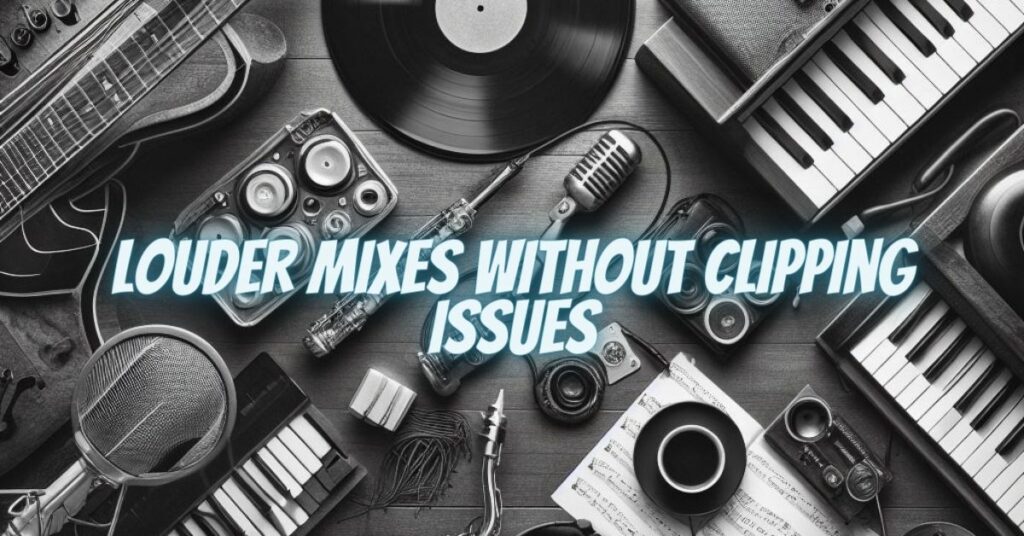Achieving a loud and impactful mix is a common goal in music production and audio engineering, but doing so without introducing clipping distortion can be challenging. Clipping occurs when the audio signal exceeds the maximum level it can handle, resulting in unwanted distortion. In this article, we’ll explore techniques and strategies to make your mix louder while avoiding clipping, so your audio remains clean and professional.
1. Gain Staging:
Proper gain staging is crucial to prevent clipping. Start by setting reasonable input levels for each track in your digital audio workstation (DAW). Avoid overdriving individual tracks or plugins, as this can lead to early clipping.
2. Use High-Quality Plugins:
Choose high-quality plugins and virtual instruments that offer headroom and maintain audio integrity even when processing audio at higher levels. Lower-quality plugins may introduce unwanted distortion or clipping.
3. Monitor Levels Carefully:
Regularly monitor and adjust the levels of your tracks, especially during mixing and mastering. Keep an eye on the master output level to ensure it doesn’t approach clipping territory.
4. Utilize Compression and Limiting:
Compression and limiting are essential tools for controlling dynamic range and increasing loudness. Use compressors to tame transient peaks, and apply limiting to ensure that the signal doesn’t exceed a predetermined threshold.
5. Multiband Compression:
Multiband compression allows you to compress different frequency bands independently. This can be particularly useful for controlling low-frequency content that might cause clipping when boosted.
6. Automation:
Automate the volume levels of individual tracks, especially when there are sections that need to be louder or quieter. This level of control ensures that you can maintain loudness without allowing tracks to clip.
7. Layering and Stacking:
Layering or stacking similar instruments or elements can create the perception of loudness without pushing individual tracks into clipping. This is particularly effective for drums, vocals, and synths.
8. Saturation and Harmonic Exciters:
Saturation plugins and harmonic exciters can add subtle harmonic content to audio, making it sound fuller and louder without increasing the peak level.
9. Mid-Side Processing:
Utilize mid-side processing to control the stereo field. You can boost the mid channel to increase the perception of loudness without pushing the side channels too hard.
10. High-Pass Filters:
Apply high-pass filters to remove low-frequency content from tracks where it’s not needed. Unnecessary low-end information can accumulate and lead to clipping.
11. Reference Mixing Levels:
Reference your mix against commercial tracks that you admire in terms of loudness. This can help you gauge the appropriate loudness level without risking clipping.
12. Use Metering Plugins:
Metering plugins, including LUFS meters, peak meters, and RMS meters, can provide real-time feedback on your mix’s loudness. They help you stay within safe levels.
13. Proper Mastering:
If you’re not confident in your mastering skills, consider having your mix professionally mastered. A mastering engineer can optimize the loudness while ensuring no clipping occurs.
14. Avoid Overcompression:
While compression is essential for loudness, overcompression can squash the dynamics and lead to a lifeless mix. Use compression judiciously.
15. Headroom in Master Channel:
Maintain some headroom in your master channel to accommodate final processing. Aim to leave at least -3 dB of headroom before applying the final limiter.
Making your mix louder without clipping is a balance between proper gain staging, dynamic control, and careful processing. By implementing these techniques and monitoring your levels diligently, you can achieve a loud and clean mix that stands out without the drawbacks of distortion or clipping. Remember that achieving loudness isn’t just about pushing levels to the max; it’s about maintaining audio quality and balance while enhancing the impact of your music.


